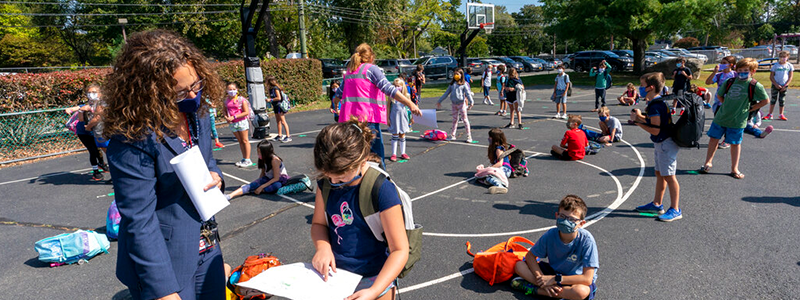Introduction | Childcare in Disasters | Broadband in Education | Mental Health and Well-Being | Emergency Shelters and Housing Security | Food Security and Poverty | Summary
Why Children Should Be the #1 Disaster Priority

Download a Print Document (PDF)
The COVID-19 pandemic, hurricanes, and other disasters remind us that our community resilience, including economic resilience, depends upon a quick return to normalcy for children and the programs that serve them, even if it’s a different normal. Without first achieving normalcy for children, returning to life-as-usual remains a distant aspiration for caregivers and parents. Returning children’s lives to normal after disaster opens the door for the greater community and economy to begin healing in full.
The Resilient Children Resilient Communities (RCRC) Initiative is a community-based model of children’s and community resilience through the lens of disaster preparedness. It is focused on strengthening the ability of child-serving institutions to respond to and recover from disasters in order to foster resiliency in children and communities. Disasters have a disproportionate and long-term impact on children,[i] yet child-serving institutions are often overlooked in disaster preparedness and response.
During times of disaster, children are vulnerable to gaps in education, adverse mental health effects, and developing chronic illness in adulthood after facing Adverse Childhood Experiences (ACEs). To address these risks, the RCRC Initiative works collaboratively with communities to enhance disaster preparedness planning in order to comprehensively integrate child–serving institutions into community-wide disaster planning processes. More resilient children are a fundamental determinant for creating resilient communities in both the short and long-term.
These issue briefs are a reflection of five years of community-based work in six communities across the United States and its territories. Phase I (2015-2018) involved two pilot communities who pioneered this innovative approach to community resilience: one in Putnam County, New York, and the other in Washington County, Arkansas. Phase II (2019-2021) introduced four additional communities: Robeson County and New Hanover County in North Carolina, and the regions of Mayagüez and Humacao in Puerto Rico, which had all been working through complex recovery efforts after catastrophic hurricanes in 2017 and 2018. With the help of the National Center for Disaster Preparedness (NCDP) at Columbia University’s Earth Institute, community voices from the six RCRC communities have identified these issue areas as topics requiring policymakers’ attention for fostering childhood resilience in disasters.
Click through this interactive map story to learn more about the communities involved in the project.
How to Use These Reports
These issue briefs are designed to be used by the RCRC communities and all other American constituencies seeking to elevate children’s disaster resilience to the attention of local, state, and federal legislators or other decision–makers. These reports can also be used by legislators and decision–makers at all levels as informative briefs to better understand the issues faced by communities in disasters as of 2021.
The issues addressed within these reports are:
- Treating childcare as an essential service during disasters
- Expanding broadband access, especially in rural areas
- Increasing mental health resources for children affected by disasters
- Prioritizing stable housing programs and kid-friendly shelters
- Prolonging emergency food security programs in impoverished areas
Each issue brief is designed to stand alone and can be shared by itself, or in tandem with the other topics. Each report begins with the testimonials of residents and leaders within the six RCRC communities followed by a data-driven national outlook. All readers are encouraged to explore the topics and voices that most resonate with their own community.
These reports, along with the interactive graphics, are free to use as aids in elevating these key issues and in contributing to increased understanding of children’s resilience in disasters.
Interconnected Systems as a Conceptual Diagram
Resilient children need strong communities capable of nurturing and supporting children through disasters. Communities are made up of complex, dynamic, and interconnected elements that impact each other. Conceptualizing the system as a whole helps us see the interconnected relationships to identify key areas for growth that can have lasting impacts. Relationships between each of the bubbles in the interactive figure below show how resources in one area can increase or decrease the strength of another.
This interactive diagram shows how each topic is part of an interconnected system. [ii] Each circle is affected when we click to increase or decrease in any one of the areas. Try this: click the “up” arrow within the red circle to see what happens when childcare resources are increased. Or try this: click the “up” arrow within the yellow “Broadband” circle to see what happens when we increase access to internet resources. Within the green “Resilience” circle, you can click “up” to see what happens when we increase disaster resilience or try clicking “down” to see what happens when we are vulnerable to disasters. Use the slider at the bottom to increase or decrease the activity speed.
____
[i] Kousky, C. (2016). Impacts of Natural Disasters on Children. The Future of Children, 26(1), 73-92. Retrieved from http://www.jstor.org/stable/43755231
[ii] Case, N. (2017). LOOPY: A Tool for Thinking in Systems. Retrieved from https://ncase.me/loopy/
Last updated: January 24, 2021
Next ››
